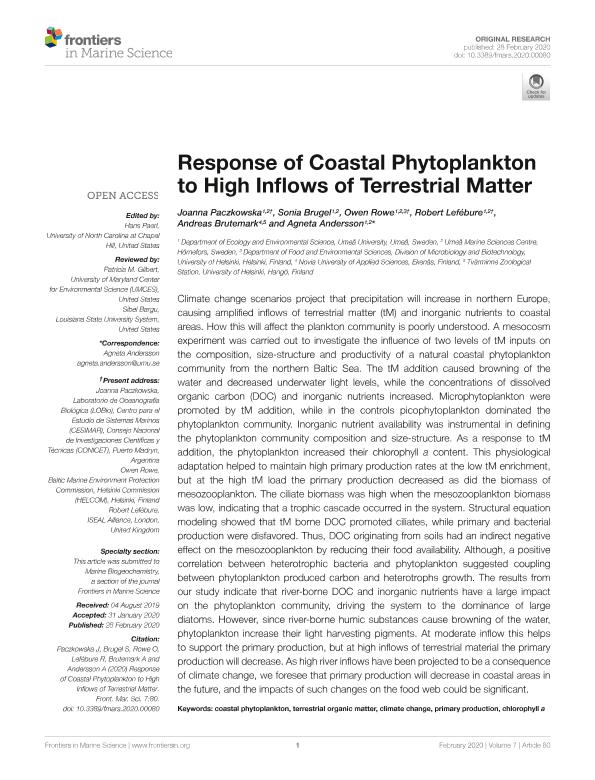Artículo
Response of Coastal Phytoplankton to High Inflows of Terrestrial Matter
Paczkowska, Joanna Marianna ; Brugel, Sonia; Rowe, Owen; Lefébure, Robert; Brutemark, Andreas; Andersson, Agneta
; Brugel, Sonia; Rowe, Owen; Lefébure, Robert; Brutemark, Andreas; Andersson, Agneta
 ; Brugel, Sonia; Rowe, Owen; Lefébure, Robert; Brutemark, Andreas; Andersson, Agneta
; Brugel, Sonia; Rowe, Owen; Lefébure, Robert; Brutemark, Andreas; Andersson, Agneta
Fecha de publicación:
02/2020
Editorial:
Frontiers Media S.A.
Revista:
Frontiers In Marine Science
ISSN:
2296-7745
Idioma:
Inglés
Tipo de recurso:
Artículo publicado
Clasificación temática:
Resumen
Climate change scenarios project that precipitation will increase in northern Europe, causing amplified inflows of terrestrial matter (tM) and inorganic nutrients to coastal areas. How this will affect the plankton community is poorly understood. A mesocosm experiment was carried out to investigate the influence of two levels of tM inputs on the composition, size-structure and productivity of a natural coastal phytoplankton community from the northern Baltic Sea. The tM addition caused browning of the water and decreased underwater light levels, while the concentrations of dissolved organic carbon (DOC) and inorganic nutrients increased. Microphytoplankton were promoted by tM addition, while in the controls picophytoplankton dominated the phytoplankton community. Inorganic nutrient availability was instrumental in defining the phytoplankton community composition and size-structure. As a response to tM addition, the phytoplankton increased their chlorophyll a content. This physiological adaptation helped to maintain high primary production rates at the low tM enrichment, but at the high tM load the primary production decreased as did the biomass of mesozooplankton. The ciliate biomass was high when the mesozooplankton biomass was low, indicating that a trophic cascade occurred in the system. Structural equation modeling showed that tM borne DOC promoted ciliates, while primary and bacterial production were disfavored. Thus, DOC originating from soils had an indirect negative effect on the mesozooplankton by reducing their food availability. Although, a positive correlation between heterotrophic bacteria and phytoplankton suggested coupling between phytoplankton produced carbon and heterotrophs growth. The results from our study indicate that river-borne DOC and inorganic nutrients have a large impact on the phytoplankton community, driving the system to the dominance of large diatoms. However, since river-borne humic substances cause browning of the water, phytoplankton increase their light harvesting pigments. At moderate inflow this helps to support the primary production, but at high inflows of terrestrial material the primary production will decrease. As high river inflows have been projected to be a consequence of climate change, we foresee that primary production will decrease in coastal areas in the future, and the impacts of such changes on the food web could be significant.
Archivos asociados
Licencia
Identificadores
Colecciones
Articulos(CESIMAR)
Articulos de CENTRO PARA EL ESTUDIO DE SISTEMAS MARINOS
Articulos de CENTRO PARA EL ESTUDIO DE SISTEMAS MARINOS
Citación
Paczkowska, Joanna Marianna; Brugel, Sonia; Rowe, Owen; Lefébure, Robert; Brutemark, Andreas; et al.; Response of Coastal Phytoplankton to High Inflows of Terrestrial Matter; Frontiers Media S.A.; Frontiers In Marine Science; 7; 2-2020
Compartir
Altmétricas



